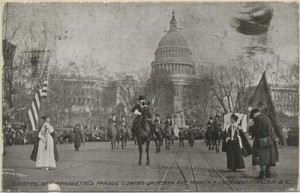In 1848, a group of women — including Lucretia Mott and Elizabeth Cady Stanton — met for tea and discussed their discontent with the limitations placed on women under America’s new democracy. That tea is seen as the beginning of the women’s rights movement.

Starting of suffragette’s parade coming up Penna. (Pennsylvania) Ave. March 3, 1913 – Washington D.C. [Postcard] The Strong Museum Collection
Out of the women’s rights movement came the desire for women to have the right to vote. Thus the suffrage movement was born. View images of suffrage postcards and parades.
![The Suffragette. "I told you so." [Postcard] Copyright 1909, by Walter Wellman The Strong Museum Collection](https://rrlc.org/winningthevote/wp-content/uploads/sites/8/2014/12/anti1-199x300.jpg)
The Suffragette. “I told you so.” [Postcard]
Copyright 1909, by Walter Wellman
The Strong Museum Collection
While many fought to give women the right to vote, others — called anti-suffragists — believed that only men should be able to vote. View images of anti-suffrage postcards.
Susan B. Anthony joined the suffrage movement in the early 1850s and became one of the movement’s strongest advocates. Although she and others worked tirelessly to gain support for women’s suffrage, it was not until 1920 that women were given the right to vote in all U.S. elections.
Susan B. Anthony lived most of her life in Rochester, New York. Rochester is part of the region in New York State that gave birth to many of the reform movements. Thus there are women and men in the Rochester region who were important to the suffrage movement. This Internet site celebrates their lives and contributions.